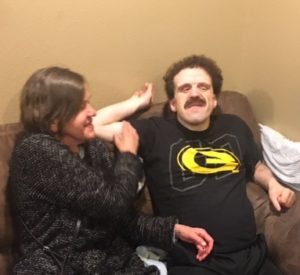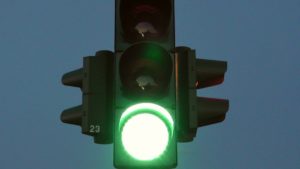Flying with a Disability: Are the Airports Ready for Us?
by Alicia Krage
Alicia’s back from her trip to reunite wit h her boyfriend in Houston — here she is with a first-person account of what it’s like to find assistance at airports now that COVID-19 regulations are loosening up.
h her boyfriend in Houston — here she is with a first-person account of what it’s like to find assistance at airports now that COVID-19 regulations are loosening up.
When reunion day finally arrived, I had no trouble getting up well before sunrise to catch an early flight at Chicago’s Midway Airport. I used VoiceOver on my iPhone to send a text to Juan, as I normally do when I wake up. My usual “Good morning’ text was then followed by, “We made it! The day is finally here!”
I arrived at Midway two hours before my flight was to depart, but the airport appeared to be understaffed and experiencing an unusually high request for assistance. Even under normal circumstances I am quite the anxious traveler, and that morning I was convinced I’d miss my flight. Using VoiceOver on my iPhone to navigate over to Juan’s name, I called him.
“No one has come to get me yet and help,” I said, getting straight to the point as soon as he answered.
“Yeah, now they typically wait until it’s closer to boarding time,” he replied calmly, not understanding the magnitude of the situation.
”No, you don’t understand. I haven’t even made it through security,” I said. “I’m pretty sure I’m going to miss this flight.”
”You’re not going to miss the flight,” he said. He didn’t sound dismissive, and he wasn’t brushing off my concerns. His calming and patient nature usually helps, but this morning I was not having it. I gave him the time of the next flight just in case. He told me to keep him updated and not to worry. “It will all be okay.”
Right as I hung up, an airline employee approached me to ask what time my flight was. I told her and added, “Pre-boarding is in 20 minutes!” She said the same thing Juan did — that everything would be okay and I was going to make this flight.
I can’t describe the feeling of relief that washed over me when I finally heard my name called. I sent a text to Juan using Siri this time, texting from my talking Apple Watch rather than my phone. “I’m on my way to security,” I said. “You’re right, I’m going to make the flight.”
Similar to my last flying experience from Midway, I was placed in a wheelchair, and they zoomed me right along to the security line. The TSA agent couldn’t figure out why I wasn’t walking through the metal detector and did not appear to know I was blind. I’m not sure if that’s because I was in a wheelchair, or if she was not previously informed.
I heard someone behind me say, “She needs help, she can’t see!” After that, the TSA agent gave me verbal directions, and off we went. After making the usual stops to the family style restroom and a place to refill my water bottle, I arrived at the gate with no time to spare.
It was time to board!
A flight attendant approached me at the gate and introduced herself. I introduced myself as well, smiled with relief, and had to add, “I’m so happy to be here, I thought I was going to miss this flight.”
”You’re here, and you have plenty of time to board,” she replied, her voice reassuring and not at all patronizing or dismissive. She led me onto the jetway, and I couldn’t stop smiling as she guided me to my seat. “Do you have a preference as to where you sit?” she asked as we stopped by a row of seats.
”Wherever gets me off the plane faster when it lands!” I said. She laughed and placed me in the second row.
“Would you like a Braille copy of the safety instructions?” she asked. I declined. They always announce the safety instructions out loud, and I find the announcements very helpful. I didn’t feel like I needed Braille instructions, but I loved that this was an option.
Upon landing, I used VoiceOver to type a text to Juan that I had landed. I was led off the jetway and placed in a wheelchair in the gate area. Once again, I became anxious, worried they’d forgotten I needed more assistance to get to baggage claim.
Houston’s Hobby Airport also appeared to be understaffed. It took roughly 10 minutes for someone to come assist me to baggage claim. But all the stress of travel was worth it when the skycap said, “I think they see you,” telling me Juan’s mom was waving us over. I practically leapt out of the wheelchair, grabbed my belongings, and got the first hug I’d received from someone outside of my family in seven months.







 At Easterseals, we believe in the power of the disability community, the unlimited potential of some 61 million Americans with disabilities. It’s undeniable. And yet, far too many adults with disabilities remain under- or unemployed, with businesses and others in our communities still failing to tap this incredible pool of talent.
At Easterseals, we believe in the power of the disability community, the unlimited potential of some 61 million Americans with disabilities. It’s undeniable. And yet, far too many adults with disabilities remain under- or unemployed, with businesses and others in our communities still failing to tap this incredible pool of talent.

 I just got word that the U.S. Department of Justice has
I just got word that the U.S. Department of Justice has 


